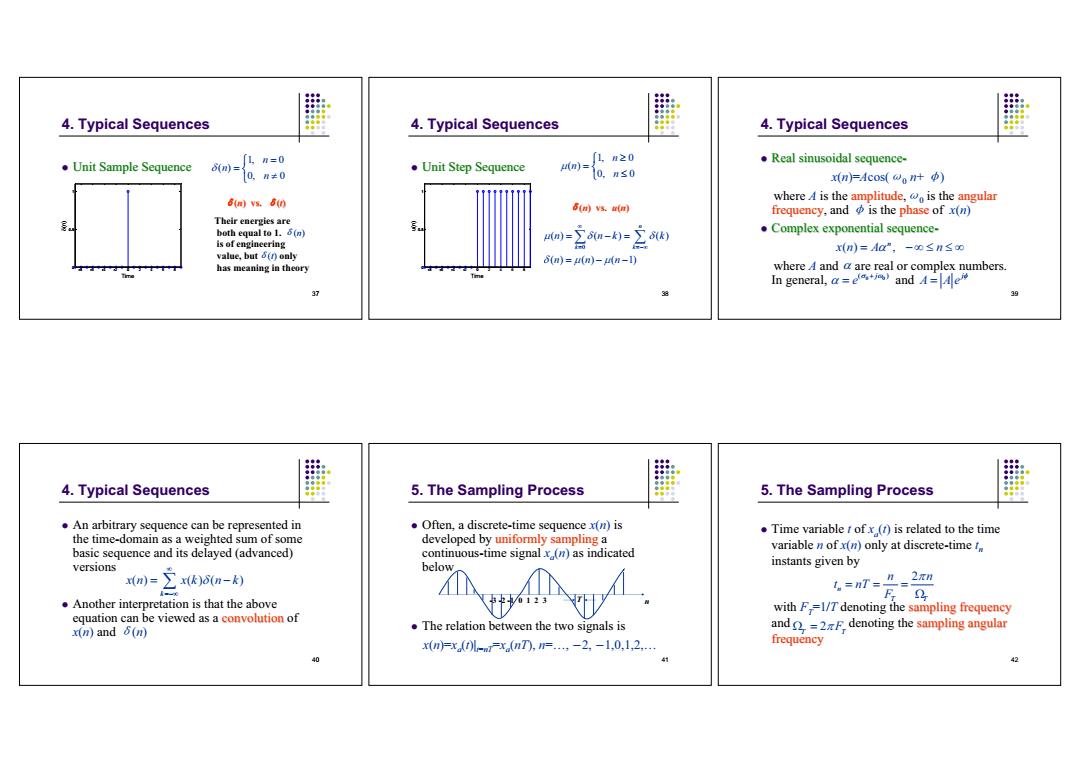正在加载图片...

4.Typical Sequences 4.Typical Sequences 4.Typical Sequences 「1,n20 ·Unit Sample Sequence ∫1,n=0 。Unit Step Sequence Real sinusoidal sequence- 4(m)= 0,n≠0 10.is0 xr(n=Acos(@on+中)】 6侧s.0 where 4 is the amplitude,o is the angular 5(m)vs.u(m) frequency,and is the phase of x(n) Their energies are both equal to 1.5(n) M(m)=6(n-k)=5(k) Complex exponential sequence- is of engineering r(n)=Aa",-0≤n≤o value,but 6(r)only 6(a)=4(a-m-1) has meaning in theory where A and a are real or complex numbers. In general,a=e)and 4=Ale 37 39 4.Typical Sequences 5.The Sampling Process 5.The Sampling Process .An arbitrary sequence can be represented in Often,a discrete-time sequence x(n)is .Time variable t ofx (r)is related to the time the time-domain as a weighted sum of some developed by uniformly sampling a basic sequence and its delayed(advanced) continuous-time signalx(n)as indicated variable n ofx(n)only at discrete-time t versions below instants given by (m)(o(-k) n。2xn 1.=nT=- F Another interpretation is that the above with F,=1/T denoting the sampling frequency equation can be viewed as a convolution of x(n)and (n) The relation between the two signals is and =2F denoting the sampling angular xn卢xt0l-nFx(nT刀,=.,-2,-1,0,1,2. frequency 名 41 4237 4. Typical Sequences Unit Sample Sequence Unit Sample Sequence ¥(n) vs. ¥(t) Their energies are both equal to 1. ¥(n) is of engineering value, but¥(t) only has meaning in theory 1, 0 ( ) 0, 0 n n n -8 -6 -4 -2 0 2 4 6 8 0 0.5 1 Time (n) 38 4. Typical Sequences Unit Step Sequence Unit Step Sequence 1, 0 ( ) 0, 0 n n n ¥(n) vs. u(n) 0 () ( ) () n k k n nk k
( ) ( ) ( 1) n nn -8 -6 -4 -2 0 2 4 6 8 0 0.5 1 Time u(n) 39 4. Typical Sequences Real sinusoidal sequence Real sinusoidal sequencex(n)=Acos(¹0 n+ ¶) where A is the amplitude amplitude,¹0 is the angular angular frequency, and ¶ is the phase of x(n) Complex exponential sequence Complex exponential sequencewhere A and are real or complex numbers. In general, and () , n xn A n
0 0 ( ) j e
j A Ae 40 4. Typical Sequences An arbitrary sequence can be represented in the time-domain as a weighted sum of some basic sequence and its delayed (advanced) versions Another interpretation is that the above equation can be viewed as a convolution of x(n) and ¥(n) () ()( ) k x n xk n k
41 5. The Sampling Process Often, a discrete-time sequence x(n) is developed by uniformly sampling a continuous-time signal xa(n) as indicated below The relation between the two signals is x(n)=xa(t)|t=nT=xa(nT), n=…, ˉ2, ˉ1,0,1,2,… -3 -2 -1 0 1 2 3 T n 42 5. The Sampling Process Time variable t of xa(t) is related to the time variable n of x(n) only at discrete-time tn instants given by with FT=1/T denoting the sampling frequency and denoting the sampling angular sampling angular frequency 2 n T T n n t nT F 2 T T F���������������������������������